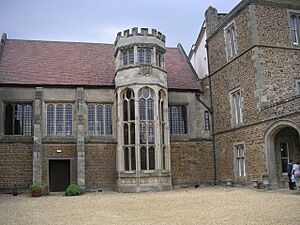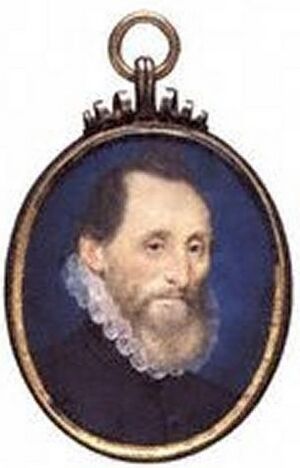Elizabeth Hussey facts for kids
Quick facts for kids Elizabeth Hussey |
|
|---|---|
| Spouse(s) | Anthony Crane, George Carleton |
| Issue | |
| Mary Crane | |
| Father | Sir Robert Hussey |
| Mother | Jane Stydolf |
| Died | c.1606 |
Elizabeth Hussey (died around 1606) was a brave woman who believed strongly in a religious movement called Puritanism. She later became known as Elizabeth Crane and Elizabeth Carleton after her marriages. She and her second husband, George Carleton, faced legal trouble because they were involved in the Marprelate controversy. This was a time when secret pamphlets were printed that criticized the church. The very first of these secret writings, called Epistle by Martin, was printed right at her home in East Molesey, Surrey, in October 1588.
Contents
Elizabeth's Family Background
Elizabeth Hussey was born when King Henry VIII was still ruling England. She was the oldest daughter of Sir Robert Hussey, who lived in Linwood, Lincolnshire. Her mother was Jane Stydolf from Surrey. Her father's brother was John Hussey, 1st Baron Hussey of Sleaford.
Her Marriages and Daughter
For a long time, people thought Elizabeth's first husband was a Puritan minister named Nicholas Crane. However, in 1931, it was discovered that her first husband was actually Anthony Crane (who died in 1583). He was an important official for Queen Elizabeth I, managing her household finances. Anthony Crane also had strong Puritan beliefs.
Elizabeth and Anthony had one daughter named Mary. Mary later married Gerald Gore. She passed away on March 1, 1606. Her husband, Gerald, lived longer than her. In 1608, records show he was still managing the land in East Molesey that had belonged to Anthony Crane.
After Anthony Crane passed away, Elizabeth married George Carleton. He was born in 1529. George was the stepfather of Sir Anthony Cope, 1st Baronet. Elizabeth and George did not have any children together.
Helping the Puritan Cause

Anthony Crane had supported religious reform as early as 1572. After his death in 1583, Elizabeth Crane continued to help Puritan writers and printers.
A servant named Nicholas Tompkins later shared a story. In May 1588, a Puritan printer named Robert Waldegrave had his printing press and type (the metal letters used for printing) destroyed by officials. This happened because he had printed a book called Diotrephes' Dialogue. Elizabeth allowed Waldegrave to bring some of his type, hidden under his cloak, to her London home.
A Puritan preacher named John Penry secretly got a new printing press for Waldegrave. In the spring of 1588, Elizabeth allowed Penry and Waldegrave to set up this new press at her country home in East Molesey, Surrey. This home was located across the River Thames from Hampton Court Palace. The first book printed on this secret press was Demonstration of Discipline.

Penry and Waldegrave then started an even more daring project. They began printing the first four of seven pamphlets written by an unknown writer using the name Martin Marprelate. These pamphlets strongly criticized the church leaders. The first of these, Martin's Epistle, was printed at Elizabeth's home in East Molesey in October 1588. It became very popular!
Because of its popularity, the church authorities started a big search for "Martin." This led Penry to move the secret press to Sir Richard Knightley's house in Fawsley, Northamptonshire. There, Martin's second pamphlet, The Epitome, was printed. Soon after, the press moved again to Whitefriars, Coventry. This was the home of Knightley's great-nephew, John Hales. Two more pamphlets, Certain Mineral and Metaphysical Schoolpoints and Hay Any Work for Cooper, were printed there.
After this, Waldegrave refused to print any more pamphlets. He said that other Puritan ministers did not approve of Martin Marprelate's strong actions.
The secret press then moved to Wolston Priory in Warwickshire, the home of Roger Wigston. In July 1589, a printer named John Hodgkins, with help from Valentine Simmes and Arthur Thomlyn, printed two more pamphlets. These were called Theses Martinianae and The Just Censure. They were known as Martin Junior and Martin Senior because they were supposedly written by Martin Marprelate's "sons."
The press was then moved to Manchester. In August 1589, agents of Henry Stanley, 4th Earl of Derby, found the press. They destroyed the pamphlet that was being printed at the time, called More Work for the Cooper. The printers were taken to London and questioned very harshly.
In early September, Henry Sharpe, who had bound the printed copies of the Marprelate pamphlets, was arrested. His questioning helped the authorities arrest most of the people involved. However, Sharpe could not identify who Martin Marprelate really was.
The last of the Marprelate pamphlets, The Protestation, was published in late September. It might have been printed at Wolston Priory.
Facing Legal Challenges
Around 1589, Elizabeth married her second husband, George Carleton. On October 1, 1589, she was questioned by church officials as Elizabeth Carleton. She bravely refused to answer any questions. She said she would not "be her own hangman" or "accuse others." Because of her refusal, she was held in the Fleet along with Sir Richard Knightley, John Hales, and Roger Wigston and his wife. The questioning of these others also failed to reveal who Martin Marprelate was. It seems that even those who helped hide the press did not know his true identity.
The exact date when charges were brought against Elizabeth Carleton in the Court of Star Chamber is not known. However, legal actions began between January and July 1590. On May 17, 1590, she gave a sworn statement from the Fleet prison. She was ordered to pay a large fine of 1000 marks for refusing to take an oath. She also had to pay £500 for helping to hide the secret printing press. The court also ordered that she remain imprisoned as long as the Queen wished. However, there are no records showing how long she stayed in prison after that.
The exact date of Elizabeth's death and where she was buried are not known. It is believed that she passed away before her daughter, Mary, who died in 1606.

